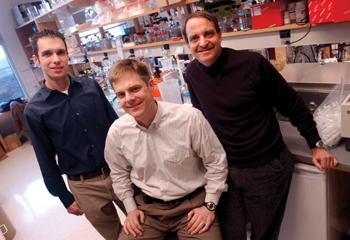
Left to right: Sean Brock, Ph.D., Dr. James Crowe and Dr. Jim Goldenring are co-authors of a Proceedings of the National Academy of Sciences paper on how respiratory syncytial virus moves into and out of cells. Photo by Dana Johnson
Synergistic science solves cells’ secret; goes where no collaboration has gone before
Dr. Jim Goldenring’s inter-departmental collaboration as a Vanderbilt researcher began practically before he was hired, when Dr. James Crowe and Sean Brock, Ph.D., approached him after he delivered a lecture here as a recruit.
Crowe, associate professor of Pediatrics and assistant professor of Microbiology and Immunology, laughs as he recalls his enthusiasm for the prospective partnership. “We had our laptops with us, ready to show him our data,” he said.
Almost one year later, this past June, the three submitted their first paper. The paper describes how the respiratory syncytial virus moves into and out of cells, like an infectious Johnny Appleseed spreading disease as it goes along.
“Apical recycling systems regulate directional budding of respiratory syncytial virus from polarized epithelial cells,” was published last month in Proceedings of the National Academy of Sciences, RSV is the most common and most prolific human virus, and it’s the culprit behind more infant and toddler hospitalizations than anything else.
As virologists, Crowe and Brock, who at the time was a Ph.D. candidate graduate student in Microbiology and Immunology, knew that RSV goes into and out of the tops of epithelial cells, but they didn’t know how. They also knew that Goldenring, while at the Medical College of Georgia, discovered a conduit called the ARE — apical recycling endosome — responsible for mediating protein sorting, basically binding to materials and pulling them into epithelial cells and then motoring (recycling) them back out the apex, or apical end, of the cell.
So Crowe and Brock hypothesized that the ARE enabled RSV’s ability to function at the apex of the cell.
After Goldenring’s lecture that day, the trio met and almost immediately began a partnership. They combined their foci into a novel approach, looking at the host, the epithelial cells, to figure out how the virus works.
The PNAS paper is yet another first, the hybrid fruit of a cross-pollination between Crowe’s lab and the Epithelial Biology Program.
Goldenring, who arrived at Vanderbilt in June of 2002, was recruited for the prescribed purposes of a.) studying epithelial cells as they relate to solid tumors and b.) enabling collaborations that never before had the chance to bud. Another collaboration, between Lynne Lapierre, Ph.D., a research assistant professor in his lab and Ann Richmond, Ph.D., professor of Cancer Biology, which also began as Goldenring’s team was being recruited, resulted in a paper in Blood earlier this year.
Virologists like Crowe enthusiastically discussed his work, and Brock seldom looked outside of viruses for answers to their questions.
“Virologists look at viruses,” Crowe said, “We had not looked at a host cell trafficking pathway as a checkpoint in this way in the past.”
Likewise, Goldenring, Paul W. Sanger Professor and vice-chair of Research, is equally excited by the synergism, and says epithelial biologists hardly ever slip a virus under their microscopes.
But the combination of disciplines demonstrated that virus trafficking pathways and cellular pathways offered a lot in common. The team armed the cells with an inhibitor of apical trafficking (dominant-negative myosin Vb) that served as a molecular yoke that prevented RSV from breaking out of the ARE. The virus stopped replicating almost completely, showing a “more than 9,000 fold reduction in viral load,” they wrote.
“This model for how to inhibit a virus could open up a paradigm for developing antimicrobials for chronic viral infections, such as HIV and hepatitis B,” by inhibiting their trafficking through host cells, Crowe said.
RSV, he explained, likely comes and goes too quickly for antivirals that work in this way to be effective; by the time the virus is identified, it has run its course.
Crowe and Brock tested other viruses, to see if ARE might allow their replication. But “the ARE does not appear to be used by flu, rotavirus or vacinnia virus in the same way,” Crowe said. “So, there must be other pathways that viruses use to move their parts around in cells. This research method could be a model to discover other pathways.”
“This study has implications for what we know about how these pathways are working. From a cellular biology point of view, each individual virus may be a window into the cells, if we can learn the process of how viruses learn the mechanism of cellular pathways,” Goldenring said. “This shows that viruses are amazingly adept at getting through cells, and that every virus has its own strategy.”
The new collaboration is as kinetic as the discovery. “This was a potent combination of the expertise of two groups,” Crowe said. “It’s exciting that Vanderbilt is at a time and a place where collaborations from completely different disciplines can form to discover a novel mechanism involving a complex of host processes. This type of collaboration will transform how viruses are studied.”
Goldenring and Crowe have more collaborations planned. The two will be part of a larger team in 2004 when they submit an NIH program project grant application with Richmond, professor of Cancer Biology, and Dr. Robert Coffey, professor of Cell & Developmental Biology and Ingram Professor of Cancer Research. The aim: to study the manipulation of intracellular epithelial cell trafficking.













